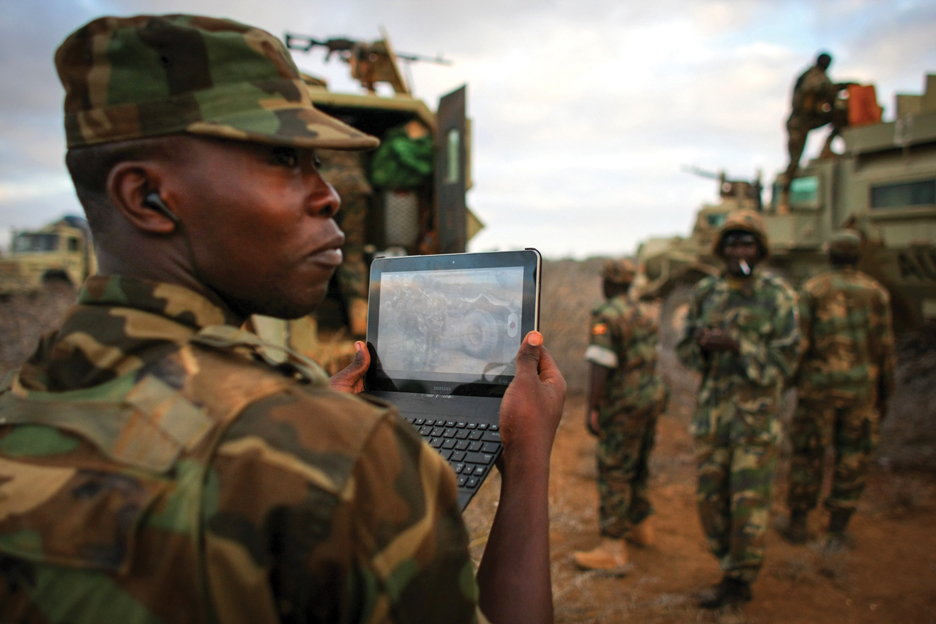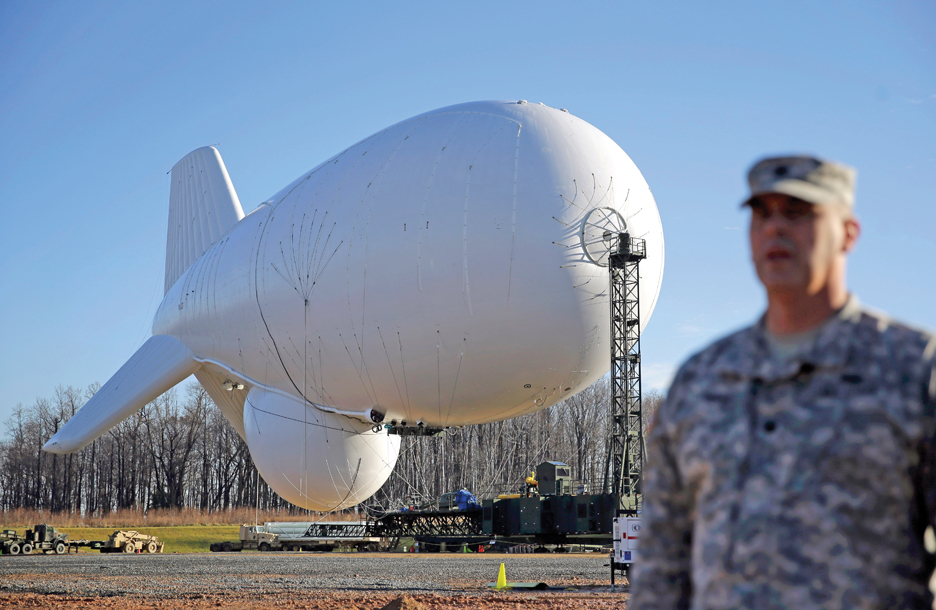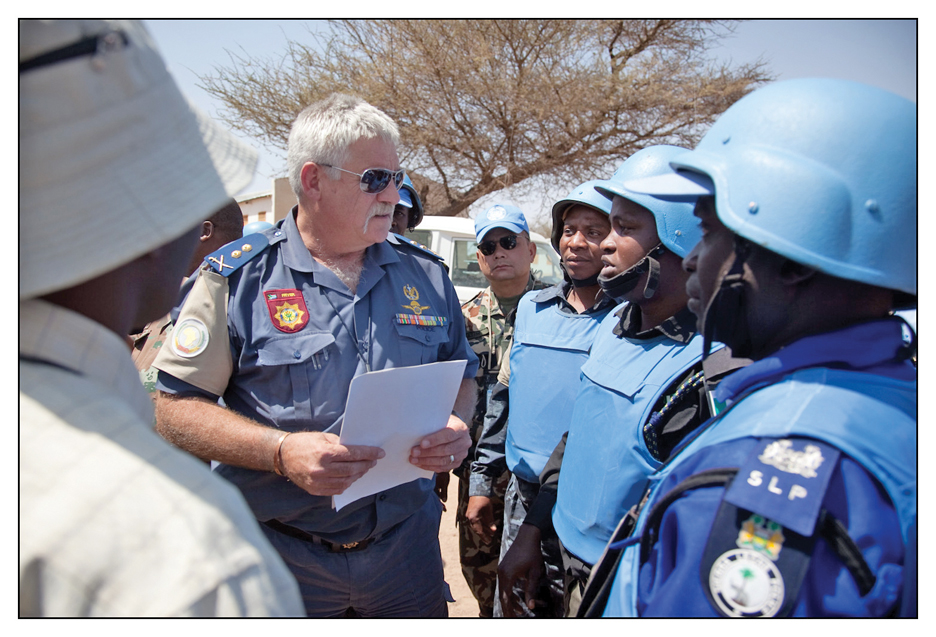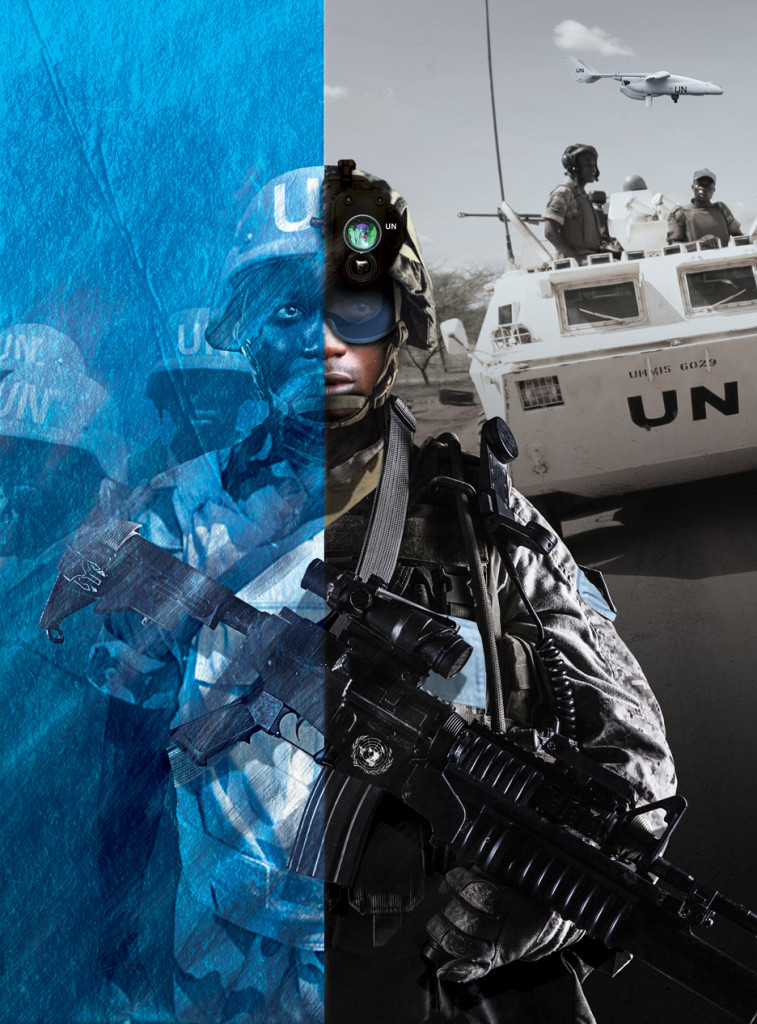Sophisticated equipment becomes more affordable and serves as a force multiplier in peacekeeping
With unmanned aircraft changing the dynamics of warfare, it should come as no surprise that the technology is changing peacekeeping as well.
Since the end of 2013, the United Nations has used unmanned aerial vehicles, also known as UAVs and drones, to fly over the volatile eastern Democratic Republic of the Congo (DRC). The 5-meter-long drones monitor remote regions that U.N. peacekeeping troops can’t reach. The drones, equipped with cameras, heat-signature equipment and night-vision technology, can conduct surveillance in the dark and detect movement below a thick tree canopy — a new frontier in intelligence-gathering.
The drones patrol the eastern border at a low altitude, monitoring rebels and militia, and also track illegal mining in the region.

The DRC mission known by the acronym MONUSCO is the first time the U.N. has used drones for peacekeeping. Although the sophisticated planes aren’t cheap, they are becoming more affordable. The initial cost of the two-drone mission was estimated at $15 million per year, or about 1 percent of the mission’s annual budget. The mission has since added three more drones, although one of them crashed in October 2014.
“They provide a very good bang for the buck,” a U.N. official told FoxNews.com. “When you are thinly spread in the region, these UAVs provide an extra set of eyes for our peacekeepers in the DRC.”
Drone use in the military is here to stay. As of early 2012, at least 10 African countries had established some type of drone program.
MODERN TECHNOLOGY IN THE FIELD
The U.N.’s use of drones for peacekeeping represents a change in philosophy where, increasingly, technology is being taken out of the office and into the field. Critics have charged in recent years that although the U.N. uses technology at its headquarters, it has been slow to adopt it for field missions.
A 2000 U.N. report called for more intensive use of global positioning equipment and other geographic information systems in peacekeeping. A similar report in 2009 called for “better use of technology to support lighter, more agile deployment.” Despite the need for more technology in peacekeeping, the Center on International Cooperation said that “many missions still lack technology that may be necessary to implement their mandates.”
Walter Dorn, who teaches at the Canadian Forces College and the Royal Military College of Canada, is one of five people appointed to a United Nations panel examining the use of technology in peacekeeping. He has written a book on the subject, Keeping Watch: Monitoring, Technology and Innovation in UN Peace Operations, published in 2011.
Dorn thinks the U.N. has some catching up to do. “Peacekeeping is no longer about the blue berets sitting between two sides, but rather a much more complex, multidimensional challenge that involves the U.N. in counterinsurgency, policing, intelligence gathering and nation building, for which new military technology is essential,” Dorn wrote.
Dorn told ADF that although expensive, high-tech equipment plays a critical role in peacekeeping, cheaper, off-the-shelf technologies such as smartphones offer the most value in missions.
“Inexpensive products such as high-zoom digital cameras, Web cameras and camcorders have become common household items,” Dorn wrote in his book. “Closed-circuit television and digital video networks are making shops and streets safer in cities around the world. But the concept of video monitoring of strategic locations in war-torn cities is a novelty in peacekeeping. Motion detectors are in widespread use in home alarm systems and in driveways, for instance in night illumination systems to alert householders to visitors and potential intruders, but they are not yet the tools of peacekeepers in the world’s hottest conflict zones.”
MINING INFORMATION
Technology is more than just gadgets — it’s also the sophisticated use of data. In a 2013 report on peacekeeping technology, researchers Anne Kahl and Helena Puig Larrauri said, “Key features of technology, both new and older, promise to make efforts in peacekeeping more effective.” In particular, they wrote, data processing could be a key component of any peacekeeping program.
Data processing involves collecting, organizing and analyzing information, which can include anything from photographs taken by drones to building databases using crowdsourcing information from emails and text messages.

“The most evident application of these tools is to help collect better data for conflict early warning systems,” the report said. The researchers specifically cited Voix des Kivus, a crowdsourcing program used in the DRC since 2009. Peter van der Windt, a New York-based researcher and teacher, was involved in the program from the start.
“Atrocities in hard-to-reach areas — for example many areas in Eastern Congo — often go unnoticed because of the lack of accessibility, both due to poor infrastructure and to the simple fact that fighting makes it too dangerous to get close,” van der Windt wrote for Ushahidi.com. “The inability of international organizations and humanitarian NGOs to collect information under these conditions hampers the provision of assistance in a timely and effective manner.
“It works like this,” van der Windt said. “In each village participating in Voix des Kivus, there are three cell phone holders: one representing the traditional leadership, one representing women’s groups, and one elected by the community. Holders are trained extensively on how to send messages to the system. They are provided with a phone, monthly credit, and a code sheet that lists possible events that can take place in the village. Sending messages to the system is free but it is also voluntary — although users do not have to pay for each message, they do not get any financial rewards for sending content to the system.
“For participating communities Voix des Kivus provides a system for creating histories, archiving testimonies, and communicating with the rest of the world about events that affect their daily lives. For researchers and practitioners working in the region, the information gathered forms an important resource to learn more about the situation on the ground in hard-to-access areas.”
NIGHT VISION CHANGES EVERYTHING
The importance of the revolution in night surveillance cannot be overstated. As Dorn has noted, with the exception of night guards, traditional peacekeeping has been a “daytime job.” And because little can be seen in the dark with the naked eye, the night gives violent parties about 10 hours of free rein.
Night-vision equipment, along with other surveillance technology, is changing the rules of night warfare. Night-vision technology is so effective, many Soldiers now refuse to go into the field without it.
Infrared radiation detectors that detect heat are the most effective tools for night vision, but they generally cost more than $5,000 per unit — an impractical price for most U.N. or African Union missions. Instead, peacekeepers are using a simple form of night vision, called image intensification. These devices detect and amplify visible light by as much as 25,000 times or more. They depend on reflected light from the night sky or from other sources.
Under excellent conditions, such as a cloudless night sky with a full moon, a sentry using a modern light intensifier can see people moving 1,500 meters away. Image intensifiers can sell for as little as $300 per unit.
THE ULTIMATE PEACEKEEPING TOOL
The most versatile tool in the peacekeeping arsenal is the cellphone, and more recently, the smartphone. Mobile use in Africa has grown faster than in any other region on Earth. There were 54 million cellphone subscribers in Africa in 2003; by the end of 2014, there were about 635 million. Africa is expected to have 930 million cellphone subscribers by 2019.
At its most basic, a cellphone can be used to alert military and police officers and coordinate aid. A modern smartphone, costing as little as $100, also can be used as a surveillance camera, an evidence-gathering device and for crowdsourcing. It is only now being developed as a translation device for peacekeepers who do not speak a common language.
Consider the sheer number of languages spoken in Africa. There are 14 major “families” of languages on the continent, with a staggering number of variations within those families. Nigeria alone has more than 500 languages. There may be more than 3,000 languages in use throughout the continent.
Language barriers have long been an obstacle for African peacekeeping missions. Training missions and peacekeeping operations have been handcuffed by differences in languages among peacekeepers and with civilians they are assigned to protect. Dorn said cellphones will change that.
“Using cellphones or the Internet, peacekeepers in the field could obtain translations from a central translation service instead of relying entirely on a translator traveling with them,” Dorn said. “Alternatively, they could check on the quality of the translations provided by persons who accompany them, especially to detect any translator bias, which is sometimes a grave problem in peace operations in divided societies.”
However, smartphone translation apps still are developing. Many require access to the Internet so the phones can tap into online dictionaries. And speech-recognition features can make errors.
“If you are a tourist on a street needing to know where the train station is, these tools are pretty good,” said Elizabeth Bernhardt, director of Stanford University’s Language Center. However, she told the San Jose Mercury News, “If I were in a business context and I had some serious negotiations going on, I would not rely on machine translation.” The same would be true of a peacekeeping mission.
For now, peacekeepers continue to rely on traditional tools for monitoring trouble areas. A standard pair of binoculars remains the critical piece of surveillance equipment. But aggressors are beginning to use modern technology, and peacekeepers will have no choice but to keep up.
Modern Peacekeeping Technology
Drone aircraft, or unmanned aerial vehicles (UAVs), have largely been used as weapons in Africa and are just now coming into their own as surveillance tools. UAVs can be as small as a bird or as large as a conventional airplane. Much less vulnerable than balloons, a UAV in the hands of an experienced ground pilot can be a surveillance tool without peer. Depending on the propulsion system, some UAVs are nearly silent.
Smartphones are the most versatile modern technology and can be used in dozens of applications on field missions. A smartphone is a phone, a camera, a video camera, an audio recorder, a walkie-talkie, a GPS, a language translator, an Internet device, a calculator and a flashlight. New applications are constantly under development. Its usefulness as a military device is unrivaled.

Digital still and video cameras can be used by peacekeepers to make images or clips for reports and databases. Rugged video cameras can cost as little as $130.
Remote video cameras can monitor hot spots even when peacekeepers are not present. They can monitor conflicts to protect civilians. Cameras can be installed to help prevent trespassing and the illegal trafficking of arms, natural resources and people. Remote cameras can transmit video in real time or images can be downloaded by passing patrols.
Helmet cameras have become standard equipment for many militaries. The view seen by a Soldier can be recorded and transmitted in real time to other Soldiers and commanding officers.
Night-vision goggles are so useful that some Soldiers insist on them for all night patrols. The view seen by a Soldier wearing such goggles can be recorded on a pocket device or transmitted in real time. Night goggles are used where night violence is a concern. Night devices can include cameras with low-light image intensifiers and cameras for infrared detection.
Motion-detector triggers for cameras can alert Soldiers about invaders and troop movements. They also can be used with lights at night to show trespassers that an area is being monitored. Such devices often are powered by solar batteries.
Computer software aggregates emails, texts and photographs to show trends, troop movements and problem areas. Such software has revolutionized crowdsourcing in Africa.
Remote microphones, triggered by unusual sounds, can be used with cameras as monitoring devices, or as standalone equipment.
Global Positioning Systems (GPS) have almost limitless military applications, from precisely pinpointing the position of aggressors, to accurately mapping directions for troops. GPS devices can be used in the dark and in unfamiliar places. They can track ground and air targets. Downed pilots and airplanes can be found quickly when equipped with GPS.
Laser range-finders can detect trespassing across borders or into restricted zones. Some finders are combined with GPS to determine the exact position of distant objects.
True geographic information systems (GIS) can replace maps. A useful GIS allows data entry and can be accessed from anywhere in real time.
Acoustic/seismic sensors can detect the movement of personnel or weapons. These sensors can trigger cameras and alert patrols. They can be used for security and to verify peace agreements.
Thermal imaging cameras, or forward-looking infrared cameras, detect infrared radiation, typically from a heat source. Generically known as FLIR technology, these cameras have distinct advantages over other imaging technologies. The cameras see radiation in the infrared spectrum, which is difficult to camouflage. They can see through smoke, fog, snow and other atmospheric conditions. And the cameras are nearly impossible for the enemy to detect because they receive information, unlike radar and sonar, which emit it. In addition to detection, FLIR technology also can be used for navigation.
Tethered balloons, also called Aerostats, equipped with day or night video cameras provide high and wide views of surveillance areas. However, such balloons can be vulnerable and are frequently used as target practice by enemy forces.
Biometric technology identifies people using tools more advanced than fingerprinting. Cameras and other image-gathering equipment can identify people based on facial features, hand geometry, retina and iris patterns, and behaviors, including type of speech or manner of walking. The European Union used iris scans to pay Congolese Soldiers, guaranteeing that no Soldier would collect pay more than once per pay period.
Surveillance Drones‘a Move in the Right Direction’
A United Nations panel member says modern technology is revolutionizing peacekeeping missions
Technology in peacekeeping is constantly changing and impacting new aspects of missions. And although the cost of surveillance and communications technology has dropped considerably, it remains beyond the means of some countries and organizations.
In June 2014, the United Nations announced the appointment of a five-member expert panel to advise the organization on how best to use new technologies to benefit peacekeeping missions.

The panel is led by American Jane Holl Lute, an expert on peace and security. The other four members are retired Lt. Gen. Abhijit Guha of India, retired Maj. Gen. Michael Fryer of South Africa, retired Maj. Gen. Ib Johannes Bager of Denmark and Dr. Walter Dorn of Canada.
The initiative is part of an effort to realize efficiency gains and cost savings from the use of new and emerging technologies and innovations.
Fryer, a former police commissioner for the U.N.-AU Mission in Darfur (UNAMID), told ADF that, ideally, peacekeeping technology can be shared among the military, civilians and police. He said there is “no need for each component to have its own technology available.”
“There are nonexpensive technologies available in the market that can make a huge difference in peacekeeping operations [PKOs],” Fryer said. His list includes mobile GPS units, lighter-than-air tethered aircraft with ground radar, closed-circuit television surveillance, forward-looking infrared cameras, mobile UHF radios, VHF repeaters, security lighting and gunshot detectors.
“Smartphones and iPads, with their endless array of apps, will definitely help a lot,” Fryer said. “They will give you real-time info, video and pictures for quick decision-making. Tracking of personnel movement will be available that will improve personnel security. The only negative aspect could be coverage in some remote areas of a PKO.”
Fryer said the use of surveillance drones, also known as unmanned aerial vehicles (UAVs), is “definitely a move in the right direction.” But he noted that the highly trained personnel needed to operate and navigate drones come at considerable expense.
Other recent studies have shown that the total cost of support personnel for drones can bring the full cost to that of manned aircraft. State-of-the-art drones should not be considered as cost-cutting alternatives to “live” aircraft.
Fryer does, however, advocate the use of drones as information-gathering tools for “integrated mission decision-making.”
“They can act as an early warning system, which enables the mission to be proactive rather than reactive,” he said. “Multitasking by mission components to specific information needs will make sure that the UAV is a mission asset.”
Fryer also thinks that smaller, more-affordable drones available commercially have a place in the future of PKOs. Such drones can be used by almost anyone with minimal training, he said. The drones could be programmed for long flying patterns over trouble areas and refugee camps to detect crime patterns and hot-spot analyses.
“During patrol in these well-known hot-spot areas, these drones could act as an early warning system for possible ambushes or other volatile situations,” he said. Such drones, he said, can fly at an altitude of 150 feet for 45 minutes. Equipped with thermal imaging, these drones have “immense value” in protecting peacekeeping forces.
Fryer regards the use of translation technology as more of the future than of the present. He added that language translation is a real problem, pointing out that South Africa alone has 11 official languages. For now, he said, “Interpreters are the only way to overcome the issue.” He said that translation software technology will be helpful for “lecture development for capacity-building efforts.”
Fryer said that, like all military equipment, peacekeeping technology must be chosen carefully.
“We do have a wide range of products that can be useful in PKOs,” he said. “But we do have to take into consideration financial implications, political implications and the ‘nice to have’ versus real needs.”

